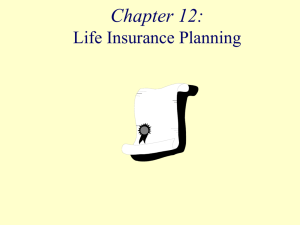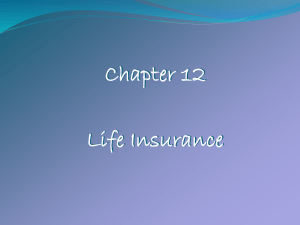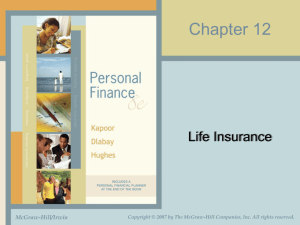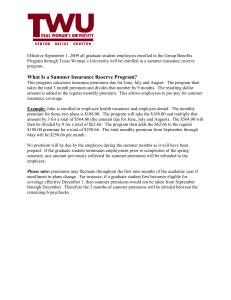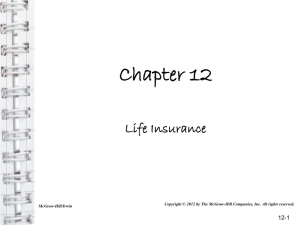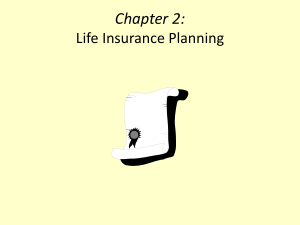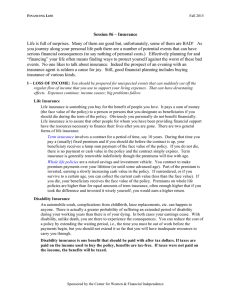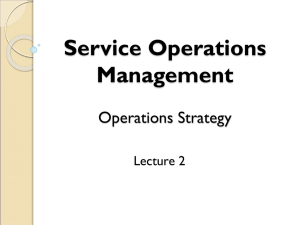Life Insurance Chapter Fourteen
advertisement
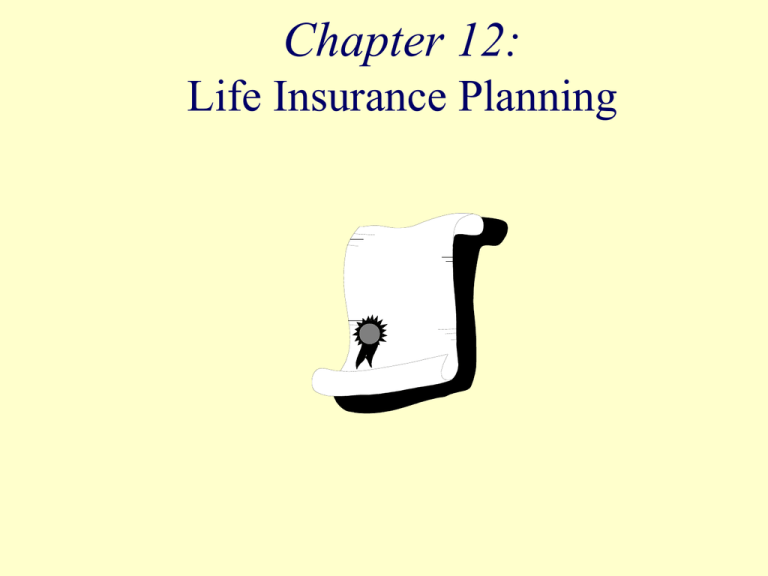
Chapter 12: Life Insurance Planning Objectives Identify the purpose of life insurance and the reasons for buying it. Recognize that the need for life insurance varies over the course of one’s life and identify the procedures used to calculate life insurance needs. Objectives Distinguish among the various types of term and cash-value life insurance policies. Describe and explain the purpose of the major provisions of life insurance policies. Discuss important points to consider when choosing and buying life insurance. What is the Purpose of Life Insurance? To protect people who depend on you from financial loss related to your death 78% of all American households have it To make charitable bequests upon your death To save money for retirement or children’s education To leave as part of your estate To pay off a mortgage or other debts at the time of death The Principle of Life Insurance Mortality tables provide odds on your dying, based on your age and sex Your premium is based on the projections for the payouts for persons who die Determining Your Life Insurance Needs - Ask Yourself... Do you need life insurance? do you have people you need to protect financially? does your partner work? What are your objectives for life insurance? to accumulate money for retirement? to provide funds when you die? how much can you afford? Estimating the Amount of Life Insurance You Need The Easy Method typically, you will need to have enough insurance to cover 70% of your income for seven years The DINK (dual income, no kids) Method The “Nonworking” Spouse Method The “Family Need” Method looks at employer provided insurance Social Security benefits income and assets Types of Life Insurance Policies Term life insurance protection for a specified period of time if you don’t pay premiums, coverage stops renewability option at the end of the term you can renew the policy without having a physical Types of Life Insurance Policies Term life insurance (continued) conversion option can change your policy from term to a whole life policy without a physical decreasing term insurance your premium stays the same, but the amount of coverage decreases as you age 12-8 Types of Life Insurance Policies (continued) Whole life insurance you pay a premium as long as you live amount of premium depends on your age when you start the policy provides death benefits and accumulates a cash value you can borrow against the cash value or draw it out at retirement look carefully at the rate of return your money earns Whole Life Policy Options Nonforfeiture clause if you stop paying premiums you can use the cash value in a variety of ways. Limited payment policy pay higher premiums during your earning years only, keeping lifetime coverage Decreasing Term Insurance Comparison of Term vs. Cash Value Other Types of Life Insurance Policies Group life insurance often through an employer no physical required usually term insurance Credit life insurance debt is paid off if you die mortgage, car, furniture also protects lenders expensive protection Life Insurance Contract Provisions Naming your beneficiary (one or more) Length of grace period for late payments Reinstatement of a lapsed policy if it has not been turned in for cash Suicide clause during first two years Automatic premium loans uses the accumulated cash value to pay the premium if you do not Life Insurance Contract Provisions (continued) Misstatement of age provision Policy loan provision can borrow against your cash value Rider to add or alter benefits cost of living protection Waiver of premium disability benefit Accidental death benefit pays twice the policy face amount Guaranteed insurability option Accelerated benefits Buying Your Life Insurance Look at your income, savings, group life insurance, and Social Security benefits Compare policy costs which are affected by cost of doing business return on its investments mortality rate among policyholders features of the policy competition from other companies Choosing Your Insurance Agent Ask friends, parents and neighbors for recommendations Find out if the agent belongs to professional groups or is a CLU Is the person willing to take the time to answer your questions and find a policy that is right for you? Do they ask about your financial plan? Do you feel pressured? Are they available when needed? Obtaining and Examining a Policy Apply and provide medical history Read all of the contract After you buy it you have ten days to change your mind Give your beneficiaries and lawyer a copy Choosing Settlement Options Options are the choices for how you want the money paid out One lump-sum is most common Limited installment plan in equal installments for a specific number of years after your death Income for life payments to the beneficiary for life Proceeds left with the company pays interest to the beneficiary
